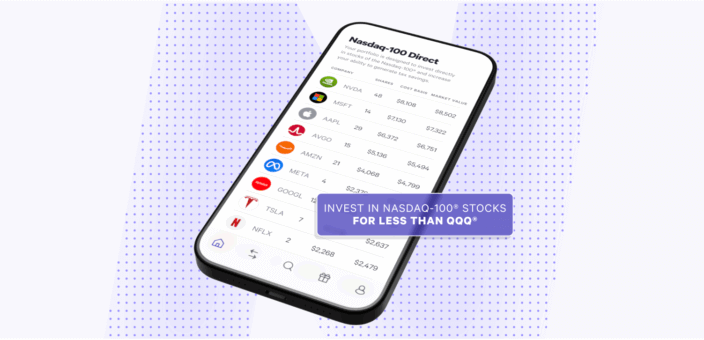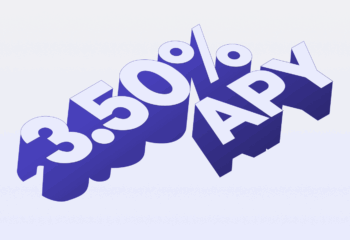For many investors, the Nasdaq-100 Index® is synonymous with innovation. This index contains the 100 largest domestic and international non-financial companies listed on the Nasdaq exchange and spans sectors including technology, healthcare, communications, and more. Investing in Nasdaq-100® ETFs like QQQ® and QQQM has long been a popular and convenient way to get exposure to some of the buzziest and most growth-oriented companies today, including Nvidia, Apple, and Meta, just to name a few. From its inception on January 31, 1985 through the end of 2024, the index has grown at an average rate of 14.25% annually (using total return).
Today, we’re thrilled to announce that Wealthfront has built an even better way to invest in the stocks that make up this celebrated index. Wealthfront’s Nasdaq-100 Direct is designed to offer similar performance to a Nasdaq-100® ETF plus valuable tax savings—all for a 0.12% annual advisory fee. This is less than the expense ratio for any Nasdaq-100® ETF, including QQQ® or QQQM. And not only is Nasdaq-100 Direct less expensive than an ETF, it is also the first-ever product to offer a direct indexing strategy for the Nasdaq-100 Index® to retail investors.
Like Wealthfront’s S&P 500 Direct, Nasdaq-100 Direct can be especially valuable if you have (or expect to have) capital gains to offset from selling company RSUs and other stock. For an overview of the benefits of Nasdaq-100 Direct, check out the video below:
How does Nasdaq-100 Direct work?
A Nasdaq-100 Direct portfolio directly holds individual stocks that make up the Nasdaq-100 Index® in your Wealthfront account. (This strategy is often called “direct indexing.”) Next, it applies Wealthfront’s automated Tax-Loss Harvesting, which is designed to turn losses into tax savings to improve your after-tax returns.

The Nasdaq-100 Index® is a natural fit for tax-toss harvesting because of its higher volatility compared to broader indices—but you can’t get this benefit from just holding a Nasdaq-100® ETF. That’s because ETFs are prevented by the Internal Revenue Code and the Investment Company Act of 1940 from passing on tax losses to investors.
Tax benefits of Nasdaq-100 Direct
Tax-loss harvesting is a strategy long used by wealthy and institutional investors to lower their tax bills and keep more of what they earn. It involves selling investments that have declined in value, “harvesting” the loss, and then buying similar investments—all the while maintaining the portfolio’s overall strategy (including the desired levels of risk and return).
Harvested losses can then be used to offset capital gains (like gains from RSUs or other stock you have sold) and up to $3,000 of ordinary income (like your paycheck). On top of this, any unused losses in the current year can be carried forward indefinitely to offset capital gains and ordinary income in future years. That is, your harvested losses never expire.
To better understand the potential tax benefits of Nasdaq-100 Direct, we think it’s helpful to look at the performance of our US Direct Indexing product, which uses the same Tax-Loss Harvesting methodology and software, but seeks to track a different index. We believe that Nasdaq-100 Direct could offer significant value in excess of what an investor could get from just owning a Nasdaq-100® ETF.
When managing the portfolio, we balance Tax-Loss Harvesting with the competing goal of generating similar performance to the Nasdaq-100 Index®. Here’s what that looks like in practice: If a company drops in value, we might sell some or even all of the portfolio’s position in that stock. Deviating from the index’s weight in that stock increases the potential for a difference in pre-tax return. To help address this, we may use cash raised from the sale to purchase stocks that are in the same industry or otherwise highly correlated with the stock we sold to reduce the expected difference.
The minimum to get started with Nasdaq-100 Direct is $5,000, but investing more means you’ll hold more individual stocks, which translates to more opportunities for our software to harvest losses on your behalf. You can learn more about the portfolio composition and strategy in our white paper.
Build wealth on your own terms
When we launched Wealthfront’s S&P 500 Direct back in December of 2024, we were delighted by the enthusiastic response from clients—we immediately knew we’d built something unique and valuable. We’re proud to bring the power of our Tax-Loss Harvesting to another prominent index, this time for less than the expense ratio of any ETF that tracks it.
Direct indexing (the industry term coined by Wealthfront in 2013 for directly owning the stocks that comprise an index fund to enable tax-loss harvesting) is offered by some financial advisors for annual fees of up to 1%, but Wealthfront uses automation to make it readily available to a much broader audience, and for significantly less cost. We’re excited to offer another powerful and accessible direct indexing product to help you reach your financial goals, whatever they may be.
Disclosure
The effectiveness of the tax-loss harvesting strategy to reduce the tax liability of the client will depend on the client’s entire tax and investment profile, including purchases and dispositions in a client’s (or client’s spouse’s) accounts outside of Wealthfront Advisers and type of investments (e.g., taxable or nontaxable) or holding period (e.g., short-term or long-term).
Keep in mind, any harvested losses are first used to offset capital gains of the same type. This means short-term losses are first deducted against short-term gains, and long-term losses are deducted against long-term gains. Net losses of either type can then be deducted against the other type of gain.
Tax-loss harvesting involves certain risks, including, among others, the risk that the new investment could have higher costs than the original investment and the strategy could introduce portfolio tracking error into your account. Tracking error is a measure of financial performance that determines the difference between the return fluctuations of an investment portfolio and the return fluctuations of a chosen benchmark. There may also be unintended tax implications.
Wealthfront Advisers’ investment strategies, including portfolio rebalancing and tax loss harvesting, can lead to high levels of trading. High levels of trading could result in (a) bid-ask spread expense; (b) trade executions that may occur at prices beyond the bid ask spread (if quantity demanded exceeds quantity available at the bid or ask); (c) trading that may adversely move prices, such that subsequent transactions occur at worse prices; (d) trading that may disqualify some dividends from qualified dividend treatment; (e) unfulfilled orders or portfolio drift, in the event that markets are disorderly or trading halts altogether; and (f) unforeseen trading errors. The performance of the new securities purchased through the tax-loss harvesting service may be better or worse than the performance of the securities that are sold for tax-loss harvesting purposes.
Tax loss harvesting may generate a higher number of trades due to attempts to capture losses. There is a chance that trading attributed to tax loss harvesting may create capital gains and wash sales and could be subject to higher transaction costs and market impacts. In addition, tax loss harvesting strategies may produce losses, which may not be offset by sufficient gains in the account and may be limited to a $3,000 deduction against income. The utilization of losses harvested through the strategy will depend upon the recognition of capital gains in the same or a future tax period, and in addition may be subject to limitations under applicable tax laws, e.g., if there are insufficient realized gains in the tax period, the use of harvested losses may be limited to a $3,000 deduction against income and distributions. Losses harvested through the strategy that are not utilized in the tax period when recognized (e.g., because of insufficient capital gains and/or significant capital loss carryforwards), generally may be carried forward to offset future capital gains, if any.
Wealthfront Advisers and its affiliates do not provide legal or tax advice and do not assume any liability for the tax consequences of any client transaction. Clients should consult with their personal tax advisors regarding the tax consequences of investing with Wealthfront Advisers and engaging in these tax strategies, based on their particular circumstances. Clients and their personal tax advisors are responsible for how the transactions conducted in an account are reported to the IRS or any other taxing authority on the investor’s personal tax returns. Wealthfront Advisers assumes no responsibility for the tax consequences to any investor of any transaction.
Indices are not available for direct investment; therefore, their performance does not reflect the expenses associated with the management of an actual portfolio.
Nasdaq 100 Direct allows clients to hold individual stocks in the Nasdaq-100 Index®, but it may not hold all the stocks in the index. As a result, its performance may deviate from that of the Nasdaq-100 Index® due to tracking error, market conditions, and the limitations of Tax-Loss Harvesting. Account size and customization options, such as excluding individual stocks, may affect the portfolio’s ability to track the Nasdaq-100 Index®.
Investing in direct indexing products and index ETFs both carry risks, including market fluctuations and tracking error. While direct indexing may offer benefits such as tax-loss harvesting and portfolio customization, it’s crucial to compare all material differences such as investment objectives, costs, liquidity, and tax features, before making an investment decision.
Nasdaq®, Nasdaq-100 Index®, NDX®, Nasdaq-100®, and QQQ® are registered trademarks of Nasdaq, Inc. (which with its affiliates is referred to as the “Corporations”) and are licensed for use by Wealthfront Advisers LLC. The Product(s) have not been passed on by the Corporations as to their legality or suitability. The Product(s) are not issued, endorsed, sold, or promoted by the Corporations. THE CORPORATIONS MAKE NO WARRANTIES AND BEAR NO LIABILITY WITH RESPECT TO THE PRODUCT(S)
The S&P 500® index is a product of S&P Dow Jones Indices LLC (“SPDJI”) and has been licensed for use by Wealthfront Advisers LLC. Standard & Poor’s®, S&P®, S&P 500®, US 500 and The 500 are trademarks of Standard & Poor’s Financial Services LLC and these trademarks have been licensed for use by SPDJI and sublicensed for certain purposes by Wealthfront Advisers LLC. Wealthfront’s S&P 500 Direct Portfolio is not sponsored, endorsed, sold or promoted by SPDJI or its affiliates and none of such parties make any representation regarding the advisability of investing in such product nor do they have any liability for any errors, omissions, or interruptions of the S&P 500®.
The information contained in this communication is provided for general informational purposes only, and should not be construed as investment or tax advice. Nothing in this communication should be construed as tax advice, a solicitation or offer, or recommendation, to buy or sell any security. Any links provided to other server sites are offered as a matter of convenience and are not intended to imply that Wealthfront Advisers or its affiliates endorses, sponsors, promotes and/or is affiliated with the owners of or participants in those sites, or endorses any information contained on those sites, unless expressly stated otherwise.
All investing involves risk, including the possible loss of money you invest, and past performance does not guarantee future performance. Please see our Full Disclosure for important details.
Investment management and advisory services are provided by Wealthfront Advisers LLC (“Wealthfront Advisers”), an SEC-registered investment adviser, and brokerage related products are provided by Wealthfront Brokerage LLC, a Member of FINRA/SIPC.
Wealthfront, Wealthfront Advisers and Wealthfront Brokerage are wholly owned subsidiaries of Wealthfront Corporation.
Copyright 2025 Wealthfront Corporation. All rights reserved.
About the author(s)
Dave Myszewski is the Vice President of Product at Wealthfront where he oversees product development, consumer research, and client support. Prior to Wealthfront, Dave worked at Apple for 12 years including an engineering role on the first iPhone. Dave holds an MS and BS in Computer Science from Stanford University. View all posts by Dave Myszewski



